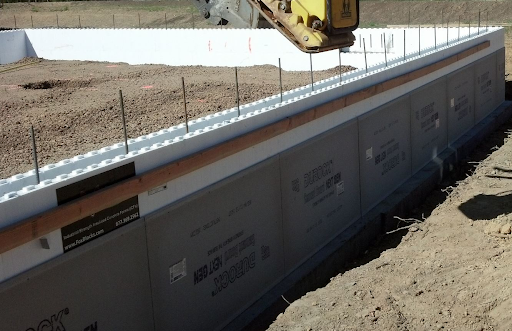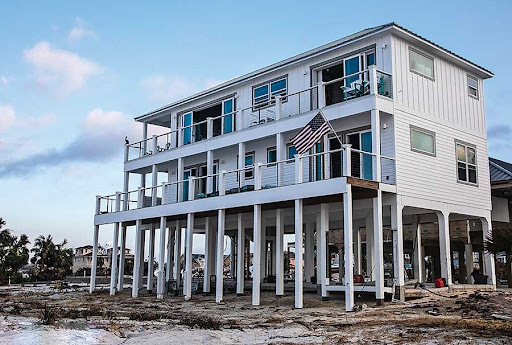
The Best Framing Option for Texas Coastal Homes

The best frames for coastal homes in Texas should provide the strength and stability to protect the 6.5 million people living along the 367 mile stretch of coastline (3,359 miles counting the tidal pools) against fierce hurricanes, tropical storms, and flooding. Texas ranks second for states that are the most hurricane-prone. In addition, scientists warn that the warming climate will intensify hurricanes and other coastal storm activity, leading to more surges, inland flooding, and tornados.

Protecting Against Severe Weather Events
Those living along the coast in Texas must prepare for increasingly severe hurricane seasons by designing their homes with framing systems that include a continuous load path. A continuous load path allows loads (uplift, lateral loads, and gravity) that strike their houses to travel from the roof, down the walls, to the foundation, and into the ground. The framing system should include wind- and flood-resistant products like Fox Blocks insulated concrete form (ICF) wall systems.
How to Pick The Best Framing Options

A home’s framing system includes the roof, foundation, and shear walls. The home’s integrity depends on the strength of each component, along with adequate connections between them.
When selecting framing methods and materials for a Texas coastal home, FEMA advises choosing framing materials resistant to flooding, intense winds, wind-driven rain, corrosion, moisture, and decay. In addition, you should also consider the ease of installation and future maintenance requirements of the framing system. ICF wall systems meet all these criteria, along with quick and easy installation and low long-term maintenance.
Along with FEMA, homeowners, builders, and architects can refer to the International Code Council (ICC) Family of Companies and the 2021 International Residential Code (IRC) for best framing options in coastal regions.
Choosing the Best Roof Framing
The roof (roof framing, roof deck pavers, sheathing, and any internal bracing) transfers horizontal loads to the walls below. Of concern, A Category 1 hurricane can damage the roof, gutters, and shingles, potentially collapsing the house. Therefore, the roof of a coastal home must comply with Chapter 9 of the 2021 IRC, along with local and state building codes. For building a durable, wind-resistant roof for Texas Coastal homes, FEMA recommends three design features:
1. Properly design and space roof-framing members
2. Provide adequate lateral bracing to support roof framing
3. Ensure a complete vertical load path between the top of the wall and the roof
Choosing the Best Foundations

A hurricane-resistant foundation often includes floor joists spanning an open space. The floor joist size should resist loads to the entire floor along with vertical loads. The floor of a hurricane-resistant house must ensure loads meet their final destination – the ground. The foundation of a hurricane-resistant home must follow Chapter 4 of the 2021 IRC, consistent with NFIP flood ordinances, along with applicable state and local codes.
The 2021 IBC and IRC contain up-to-date wind provisions for foundation design in coastal areas, consistent with NFIP flood provisions. In addition, builders and architects must address locally adopted building ordinances. The design and construction of a coastal foundation should adequately support the elevated home, resisting all wind loads and preventing flotation, collapse, or lateral movement of the house. Foundations in flood-prone coastal areas must consider storm surge, wave action, and erosion, unlike less flood-prone inland foundations.
Choosing the Best Exterior Wall Framing

The structural capacity and stiffness of coastal exterior walls must withstand the in-plane shear forces of hurricane winds, minimizing the lateral twists that can damage the non-structural elements (mechanical, plumbing, electrical, and mechanical). In addition, the walls must stop the penetration of flying debris from penetrating them during high wind events.
Exterior walls must comply with Chapter 6 of the 2021 IRC, and local and state building codes.
Fox Block ICFs Is the Best Framing Option for Coastal Homes in Texas
Quick and easy-to-install Fox Blocks insulated concrete forms (ICFs) are the best exterior wall framing option for a Texas Coastal home to combat severe winds and flooding, compared to wood, steel, or concrete masonry units (CMU).
Disaster-resistant
Fox Blocks ICF withstand winds of over 200 mph and projectile debris traveling over 100 mph, providing more protection against extreme wind events than wood and steel framing.
A Portland Cement Association (PCA) study compared the structural load resistance of wood- and steel-framed walls to ICF walls. The study found higher structural capacity and stiffness to resist in-plane shear forces (winds, earthquakes) in the ICF walls than wood or steel frame walls. In addition, the durability of concrete walls minimizes lateral twists.
A study by Texas Tech University compared the impact resistance of wind-driven debris between traditionally framed and ICF walls. The study concluded that ICF walls resist the impact of wind-driven debris, while traditional framing couldn’t prevent the penetration of airborne debris into the walls.
Flood-resistant
Fox Blocks solid continuous monolithic concrete walls provide permeability (perm rating below 1.0) and moisture resistance. Fox Blocks ensure that moisture within a wall framing system will dry out and not travel to nearby building components. In addition, Fox Blocks reinforced concrete construction won't degrade when wet, and will maintain its original shape and integrity during and after a flood.
ICF for Superior Flood Resistance

TheASCE 24 is the referenced standard in IBC used by builders, architects, and homeowners, that dictates the design of homes built in flood hazard zones. It provides the minimum requirements and expected performance for the design and construction of houses in flood hazard areas, and it complies with the National Flood Insurance Program (NFIP) minimum requirements, the agency that defines a flood-resistant material.
The NFIP defines a flood-resistant material as a building product able to withstand direct and extended contact (72 hours) of floodwaters without sustaining significant damage (more than cosmetic repair) or damage to adjacent material or systems. NFIP classifies building materials according to their ability to resist flood damage from one to five. A class five-building material stands up to flood water damage, surviving wetting and drying. In addition, a class five product will maintain its integrity after you clean it of harmful pollutants from the flood.
The NFIP classifies ICFs as five, making it a superior wall framing choice for a Texas Coastal home. Unfortunately, wood-frame homes can accumulate moisture in their wall cavities because the practical methods that stop water from entering a wall system may also prevent the moisture from leaving it.
ICFs Lessen Construction Time
Fox Block ICF construction saves construction time over wood or CMS home construction. Unlike these other two methods, ICF construction completes framing, continuous insulation, furring attachments, and air and vapor barrier all in one step.
A few trained ICF builders can lay the blocks for a single-story home in one day - pouring the concrete on the next day. In just two days, builders can frame and wrap a house, making it ready for the roof and inside and outside finishings.
ICFs also eliminates the need for sealing and caulking and interior and exterior barriers. ICF subcontractors can quickly install plumbing, electrical, and HVAC because of the ease in cutting the foam.
Learning from Gulf Coast Hurricanes: ICF Homes Survived Both Harvey and Michael
In recent years, two major hurricanes hit the Gulf Coast, Hurricanes Harvey, and Michael, both leaving behind significant and costly damage, and destroying many homes in their paths. In both cases, however, ICF homes survived the devastation.
Fox Blocks ICF Home Survives Hurricane Harvey
Hurricane Harvey, one of the most catastrophic storms to hit Texas in 2017, brought intense 130 mph winds and severe flooding (up to 60.58 inches of water) along the Gulf Coast, including Corpus Christi, Galveston, and the hardest-hit, Houston. Hurricane Harvey displaced 30,000 people, caused $125 billion in damages, and destroyed or damaged 135,000 homes, making it the second most expensive hurricane in U.S. history. Sadly, Harvey claimed at least 82 lives in Texas (the deadliest hurricane to hit Texas since 1919), including those who died due to the storm, drowning in flash floods, or on roads.
Casa Tres Playas in Corpus Christi, Texas

The Casa Tres Playas, a 9,000-ft2 beach house, includes more than 1,100 linear feet of ICF wall, 12 different wall heights, and 15,000 ft2 of forms. The strength and integrity of this ICF home resisted the full fury of Hurricane Harvey, experiencing only slight cosmetic damage caused by flying debris, but no structural damage. The windows and doors remained intact. There was no water intrusion except a small puddle that occurred at the height of the storm when the giant glass door flexed. The family returned home soon after the power came back on in the area.
ICF Home Survives Hurricane Micheal
Hurricane Micheal made landfall near Mexico Beach, Florida, in 2018 with sustaining winds of 155 mph — the most intense hurricane on record along the Florida Panhandle. The winds and flooding caused by Micheal cost $25 billion, damaged nearly 60,000 houses, and killed at least 45 people.
The Sand Castle in Mexico City, Florida


Constructed in 2018, this beachfront ICF house, just a few hundred feet from the water’s edge, survived Hurricane Michael’s winds of over 150 mph, virtually unscathed, unlike many of its neighbors.
Fox Block ICFs Provide the Best Framing Option for Texas Coastal Homes
The Fox Blocks ICF wall system contributes significantly to creating a strong and stable framing system capable of standing up to the extreme winds and heavy flooding along the Texas Coast. Fox Blocks make energy-efficient and pest- and fire-resistant homes with excellent indoor air quality. ICFs provide a quick and straightforward method to construct a new home, saving money and time, during and after construction, compared to other traditional building methods.
Find a Fox Blocks dealer today for more on the best framing options for a Texas coastal home.